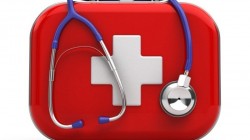Act fast by knowing when to go to the emergency room.
 At a very young age, we learn to call 911 in the event of an emergency; however, how do we know when we’re faced with a true emergency? When making the decision of whether to go to the emergency room or stay home, it is important to act fast.
At a very young age, we learn to call 911 in the event of an emergency; however, how do we know when we’re faced with a true emergency? When making the decision of whether to go to the emergency room or stay home, it is important to act fast.
“Time is crucial, and minutes can be the difference between life and death, especially when dealing with heart attack or stroke,” explains Dr. Matthew Bernard, Touro’s Emergency Department Director.
WHEN TO CALL 911
If you or a loved one experiences any of following, it is best to go to the ER:
- Chest pain, discomfort or a squeezing sensation in the chest
- Seizure
- Signs of a stroke
- Loss of consciousness
- A blow to the head
- Broken bone
- Sudden disorientation
- Serious burn
- Severe abdominal pain
- Uncontrolled, continued vomiting
- Sudden change in motor skills, such as paralysis or slurred speech
- Uncontrolled, continuous bleeding
UNDERSTAND THE SYMPTOMS
Heart Attack
Women are less likely to experience the typical symptoms — like pain in the chest, left arm or jaw — but they may experience shortness of breath, sudden dizziness, nausea or unexplained sweating and fatigue. If you think you are having a heart attack, call 911. Do not drive yourself or have someone else drive you.
Stroke
Telltale signs of a stroke include sudden numbness or weakness in a limb or one side of your face, sudden slurring of speech, trouble seeing, unexpected dizziness or loss of balance, or an excruciating headache. Dr. Bernard reminds people to remember the acronym FAST when faced with possible stroke symptoms: Face drooping, Arm drooping, Speech slurring and Time (which is critical).
BE PREPARED
A trip to the emergency room is never planned, so it’s best to be prepared. Creating an emergency file for your household can be beneficial. Dr. Bernard shares some advice about what you should keep in a file to make any visit to the emergency room more efficient.
- A document of your medical history
- An up-to-date list of medications or supplements you may be taking
- A list of any allergies
- Your emergency contact information
- Your physicians’ contact information
- The name and contact information of your health insurance provider
“Technology is great for this,” says Dr. Bernard. “There are several apps available that can keep track of this information for you, as well as bracelets or necklaces that you can wear to identify a chronic condition. You can also just create a note on your phone — whatever makes it easiest for you to create and keep up-to-date.”
WHAT TO BRING
Though it is important to act fast in an emergency, if time allows, there are certain items that are helpful to have with you when you go to the ER.
- Your medical file
- Your insurance card
- Something to document the treatment you or your loved one receives
TOURO’S EMERGENCY SERVICES
Last year, Touro’s full-service, comprehensive Emergency Department saw more than 35,000 emergency patients. Dr. Bernard says his ER board-certified physicians have been working together for many years, which lets them streamline the process to efficiently deliver the care patients need. The hospital invests in the latest technology to deliver faster results and more successful treatment.
“We have to keep in mind that we are in the service industry,” laughs Dr. Bernard. “We want our patients’ experience to be quick, but not rushed.” Since September, the Touro Emergency Department has received a 97-percent satisfaction rate on Patient Satisfaction Surveys.
BOTTOM LINE
“Remember, it is always better to be safe than sorry,” cautions Dr. Bernard. “If you feel it is an emergency, call 911 and ask them to send an ambulance right away. You are never wrong about going to the ER.”
